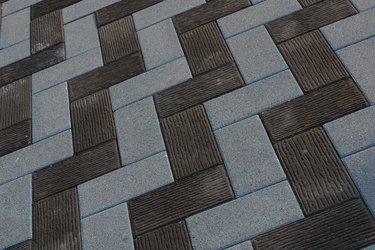Things You'll Need
Ceramic tile
Window glass
Steel file

Ceramic tile floor tiles are an eco-smart, durable, easily maintained and beautiful flooring solution. Installed properly, quality ceramic tile will last a lifetime. Ceramic tile has been the flooring of choice in high traffic areas from ancient Rome to the most modern contemporary building designs. Selecting high quality floor tiles means doing a little homework before you purchase. Find a tile you love. Get the technical information you need. Make smart decisions.
Step 1
Check the grade of the tile. Sold as standard grade, a ceramic tile passes a visual inspection for color consistency and warping at a distance of three feet. Inspection of second grade tile is done at a distance of ten feet. Irregular glaze, inconsistent thickness, or defective color match within the batch, will be sold as salvage.
Video of the Day
Step 2
Examine the tile label and the manufacturers' technical information about the tile for the durability classification. Classifications are 0-Not flooring; I-Light traffic floors; II-Medium traffic residential floors; III-All residential floors; IV-Commercial floors; IV-Extra Heavy traffic. Purchase tile using this classification system to ensure that the selection is appropriate for your needs.
Step 3
Purchase only tile that has been rated as slip resistance as determined by laboratory test. Slip resistance is defined as the amount of resistance tile offers a shoe sole material to the flooring material wet or dry. Install only high rated slip resistant flooring in kitchens, baths and entry ways. Avoid installation of a high gloss glaze tile on heavily used floors. The high shine glazes scratch easily and are very slippery when wet.
Step 4
Test the hardness of the tile yourself by using the Moh Hardness test to determine what material scratches another material. Use the Moh Hardness scale to rate materials on a scale of one to ten, with ten being the hardest. The scale is 1-Talc; 2-Gypsum (or a fingernail); 3-Calcite (or a copper penny); 4-Flourite; 5-Apatite (or window glass); 6-Feldspar (or a steel file); 7-Quartz; 8-Topaz; 9-Corundum; and 10-Diamond. If the hardness is over six, it is perfect for a durable floor. Durable ceramic tile flooring must have a hardness of 6 or better.
Step 5
Buy solid body tile, which has the same color throughout, for heavy traffic areas. Avoid using a red or brown body tile with a light color glaze on floors because a scratch or chip will show the red or brown body color under the glaze. Use tile with a body color similar to the top color to avoid problems with small chips or scratches.
Step 6
Look for warping by examining a few tiles in each box. Mix multiple boxes during installation to obscure any variation in the thicknesses of the tile or corner curl that may be present. Compensate for slight warping during installation by increasing the mortar bed underneath the tile.
Step 7
Seal grout lines on all glazed tiles floors but not the tiles themselves. Seal both tiles and the grout lines on floors with unglazed tile with sealers recommended by the tile manufacturer. Sealing the tiles and grout will make cleaning and maintenance of the ceramic tile floors easier. Sealing tiles will also help protect the glaze from scratch damage.
Video of the Day